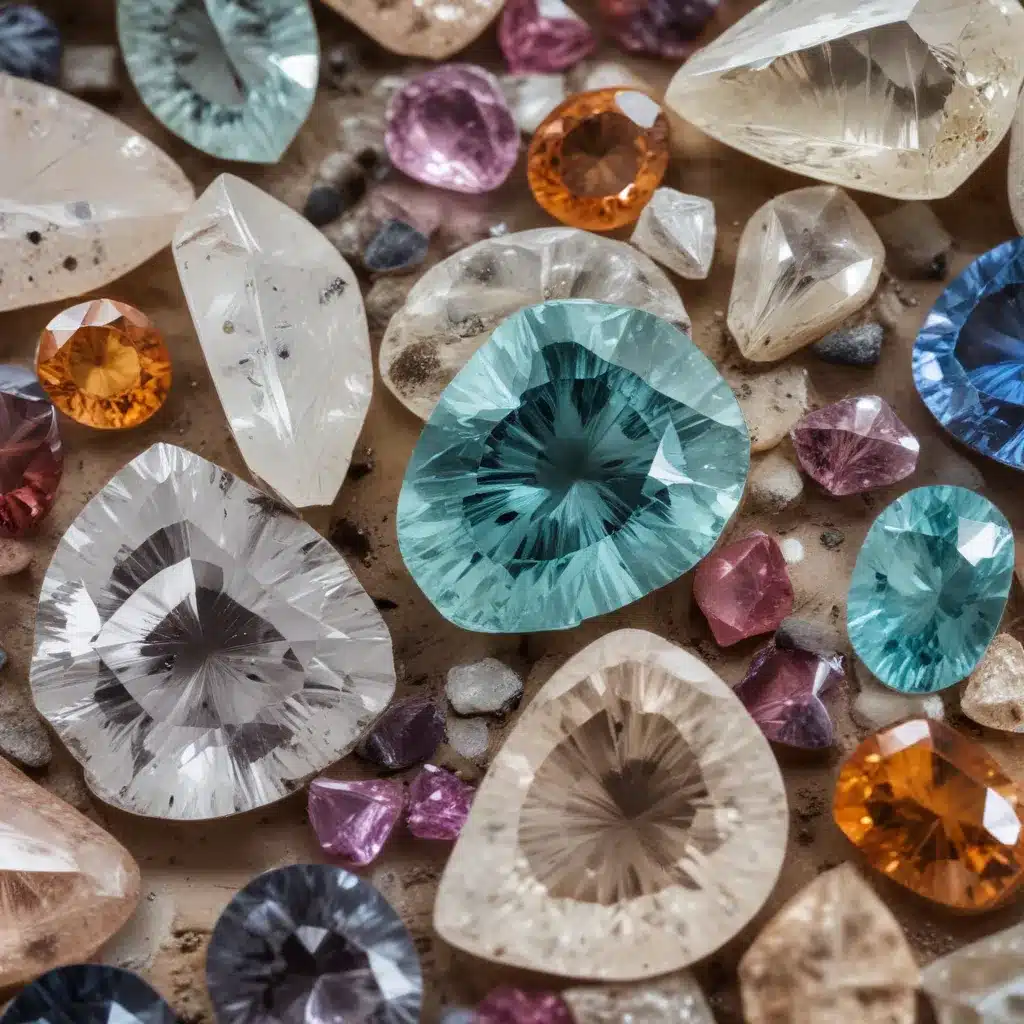
The Science of Gemstone Inclusions: Revealing the Hidden Stories Within
As a gem and jewelry expert at Shelby Gem Factory, I have a deep fascination with the hidden stories locked within gemstones. These tales are etched in the very fabric of the stones, encoded in the form of microscopic inclusions—materials or structural imperfections trapped as the gem formed deep within the Earth.
Gemstone inclusions are like natural time capsules, preserving snapshots of the extraordinary geological processes that birthed these sparkling treasures. From tiny mineral crystals to gas bubbles, each inclusion offers a unique glimpse into the gem’s formative history. By delving into the science behind these inclusions, we can unlock a wealth of insights about the gems we cherish.
Types of Gemstone Inclusions
Mineral inclusions are perhaps the most common, consisting of other mineral fragments trapped within the host gemstone. Imagine a sapphire with tiny garnet crystals suspended inside—a testament to the diverse geological environments in which the gem was born.
Fluid inclusions, on the other hand, are tiny pockets of liquid, often ancient water, sealed within the gemstone. These inclusions are like time capsules, preserving the very fluids that may have been present during the gem’s formation.
Gaseous inclusions appear as bubbles or cavities within the stone, hinting at rapid changes in pressure or temperature that occurred as the gem grew. These inclusions can provide clues about the dynamic conditions deep underground.
Understanding Inclusion Formation
Gemstone inclusions form as the crystal grows, much like a tree acquiring nesting birds over time. As the gem develops, it may trap nearby minerals, fluids, or gases, freezing them in place and preserving a record of the gem’s formative conditions.
By studying the size, shape, and distribution of inclusions, gemologists can piece together the complex geological history of a gemstone. Inclusions act as a gemstone’s “DNA,” offering insights into the temperature, pressure, and chemical composition of the environment in which it formed.
Gemological Examination Techniques
Identifying and interpreting gemstone inclusions is a skilled art that relies on a range of advanced analytical tools. Optical microscopes allow gemologists to closely examine the inclusions, while techniques like Raman spectroscopy and infrared spectroscopy can provide detailed chemical analyses.
X-ray imaging and computed tomography (CT) scanning offer three-dimensional views of a gem’s internal structure, revealing the size, shape, and spatial arrangement of inclusions in unprecedented detail. These techniques are invaluable for distinguishing natural gems from their synthetic counterparts.
Inclusions and Gemstone Identification
Inclusions are not just interesting geological curiosities—they are also critical tools for gemstone identification and authentication. Each type of gem has its own characteristic inclusion “fingerprint,” which gemologists use to determine a stone’s identity and origin.
For example, the presence of rutile needles in a sapphire is a telltale sign of natural origin, while the absence of certain inclusions may indicate a synthetic stone. Gemological reports detailing a gem’s inclusion profile are vital for buyers and sellers, ensuring transparency and trust in the marketplace.
Inclusions and Gemstone Quality
Inclusions can also play a significant role in a gemstone’s clarity and, consequently, its value. Gems with fewer visible inclusions typically receive higher clarity grades and command higher prices. However, this is not always a hard-and-fast rule, as some types of gems, like emeralds, are expected to have inclusions that add to their character and appeal.
Gemologists carefully examine the size, number, and location of inclusions to assess a gem’s clarity. This information is then used to determine the stone’s overall quality and provide guidance on pricing and value.
Inclusions and Geological History
But gemstone inclusions are more than just tools for identification and quality assessment. They are also invaluable sources of information about the Earth’s geological history and the formation of these precious crystals.
By analyzing the mineral, fluid, and gaseous inclusions trapped within gems, scientists can reconstruct the temperature, pressure, and chemical conditions that prevailed deep within the Earth’s crust and mantle. This knowledge helps us better understand the complex processes that give rise to the extraordinary diversity of gemstones found around the world.
Inclusions in Synthetic and Treated Gems
The study of inclusions is just as important for synthetic and treated gemstones as it is for natural gems. Inclusions can reveal telltale signs of man-made or enhanced origins, allowing gemologists to distinguish them from their natural counterparts.
For example, the presence of unusual inclusion patterns or the absence of certain expected inclusions can indicate that a gem has been grown in a laboratory. Inclusions can also provide clues about the specific treatments a gemstone has undergone, such as heat treatment or fracture filling.
Inclusions and Artistic Expression
But gemstone inclusions are not just scientifically fascinating—they can also be visually captivating. Some gems, like star sapphires and emeralds, owe their distinctive and desirable visual effects to the presence of oriented mineral inclusions.
Artisans have long embraced the natural beauty of inclusions, incorporating them into unique gem carvings and jewelry designs. The interplay of light and the hidden worlds within the stones can create mesmerizing effects, blurring the line between science and art.
Inclusions and Sustainability
As the demand for ethically sourced and sustainable gems continues to grow, the study of inclusions has become increasingly important. Inclusions can provide valuable insights into the environmental and social impacts of gemstone mining, informing responsible sourcing practices and traceability efforts.
By understanding the geological context in which gems form, we can make more informed decisions about the extraction and processing of these natural resources. Embracing the stories hidden within gemstone inclusions is not just a scientific pursuit—it is also a step towards a more sustainable and equitable gem and jewelry industry.
In conclusion, the world of gemstone inclusions is a treasure trove of scientific and artistic wonder. From revealing the geological origins of gems to inspiring unique jewelry designs, these microscopic features are windows into the very heart of the Earth’s most captivating creations. By unlocking the secrets of gemstone inclusions, we can deepen our appreciation for the natural masterpieces that adorn our world.

